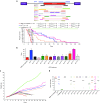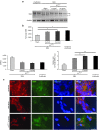Optimization of Morpholino Antisense Oligonucleotides Targeting the Intronic Repressor Element1 in Spinal Muscular Atrophy
- PMID: 27401142
- PMCID: PMC5113110
- DOI: 10.1038/mt.2016.145
Optimization of Morpholino Antisense Oligonucleotides Targeting the Intronic Repressor Element1 in Spinal Muscular Atrophy
Abstract
Loss of Survival Motor Neuron-1 (SMN1) causes Spinal Muscular Atrophy, a devastating neurodegenerative disease. SMN2 is a nearly identical copy gene; however SMN2 cannot prevent disease development in the absence of SMN1 since the majority of SMN2-derived transcripts are alternatively spliced, encoding a truncated, unstable protein lacking exon 7. Nevertheless, SMN2 retains the ability to produce low levels of functional protein. Previously we have described a splice-switching Morpholino antisense oligonucleotide (ASO) sequence that targets a potent intronic repressor, Element1 (E1), located upstream of SMN2 exon 7. In this study, we have assessed a novel panel of Morpholino ASOs with the goal of optimizing E1 ASO activity. Screening for efficacy in the SMNΔ7 mouse model, a single ASO variant was more active in vivo compared with the original E1(MO)-ASO. Sequence variant eleven (E1(MOv11)) consistently showed greater efficacy by increasing the lifespan of severe Spinal Muscular Atrophy mice after a single intracerebroventricular injection in the central nervous system, exhibited a strong dose-response across an order of magnitude, and demonstrated excellent target engagement by partially reversing the pathogenic SMN2 splicing event. We conclude that Morpholino modified ASOs are effective in modifying SMN2 splicing and have the potential for future Spinal Muscular Atrophy clinical applications.
Figures






Similar articles
-
Morpholino antisense oligonucleotides targeting intronic repressor Element1 improve phenotype in SMA mouse models.Hum Mol Genet. 2014 Sep 15;23(18):4832-45. doi: 10.1093/hmg/ddu198. Epub 2014 Apr 29. Hum Mol Genet. 2014. PMID: 24781211 Free PMC article.
-
Improved antisense oligonucleotide design to suppress aberrant SMN2 gene transcript processing: towards a treatment for spinal muscular atrophy.PLoS One. 2013 Apr 22;8(4):e62114. doi: 10.1371/journal.pone.0062114. Print 2013. PLoS One. 2013. PMID: 23630626 Free PMC article.
-
Bifunctional RNAs targeting the intronic splicing silencer N1 increase SMN levels and reduce disease severity in an animal model of spinal muscular atrophy.Mol Ther. 2012 Jan;20(1):119-26. doi: 10.1038/mt.2011.232. Epub 2011 Oct 25. Mol Ther. 2012. PMID: 22031236 Free PMC article.
-
Spinal muscular atrophy: antisense oligonucleotide therapy opens the door to an integrated therapeutic landscape.Hum Mol Genet. 2017 Oct 1;26(R2):R151-R159. doi: 10.1093/hmg/ddx215. Hum Mol Genet. 2017. PMID: 28977438 Review.
-
Recent Advances and Clinical Applications of Exon Inclusion for Spinal Muscular Atrophy.Methods Mol Biol. 2018;1828:57-68. doi: 10.1007/978-1-4939-8651-4_3. Methods Mol Biol. 2018. PMID: 30171534 Review.
Cited by
-
Development of 2'-O-Methyl and LNA Antisense Oligonucleotides for SMN2 Splicing Correction in SMA Cells.Biomedicines. 2023 Nov 16;11(11):3071. doi: 10.3390/biomedicines11113071. Biomedicines. 2023. PMID: 38002071 Free PMC article.
-
Drug treatment for spinal muscular atrophy type I.Cochrane Database Syst Rev. 2019 Dec 11;12(12):CD006281. doi: 10.1002/14651858.CD006281.pub5. Cochrane Database Syst Rev. 2019. PMID: 31825542 Free PMC article.
-
Drug treatment for spinal muscular atrophy types II and III.Cochrane Database Syst Rev. 2020 Jan 6;1(1):CD006282. doi: 10.1002/14651858.CD006282.pub5. Cochrane Database Syst Rev. 2020. PMID: 32006461 Free PMC article.
-
Spinal muscular atrophy: From approved therapies to future therapeutic targets for personalized medicine.Cell Rep Med. 2021 Jul 21;2(7):100346. doi: 10.1016/j.xcrm.2021.100346. eCollection 2021 Jul 20. Cell Rep Med. 2021. PMID: 34337562 Free PMC article. Review.
-
Exploring Motor Neuron Diseases Using iPSC Platforms.Stem Cells. 2022 Mar 3;40(1):2-13. doi: 10.1093/stmcls/sxab006. Stem Cells. 2022. PMID: 35511862 Free PMC article.
References
-
- Monani, UR, Lorson, CL, Parsons, DW, Prior, TW, Androphy, EJ, Burghes, AH et al. (1999). A single nucleotide difference that alters splicing patterns distinguishes the SMA gene SMN1 from the copy gene SMN2. Hum Mol Genet 8: 1177–1183. - PubMed
-
- Miyajima, H, Miyaso, H, Okumura, M, Kurisu, J and Imaizumi, K (2002). Identification of a cis-acting element for the regulation of SMN exon 7 splicing. J Biol Chem 277: 23271–23277. - PubMed
Publication types
MeSH terms
Substances
Grants and funding
LinkOut - more resources
Full Text Sources
Other Literature Sources
Medical

